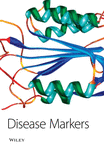Predictive Role of Cytokine Gene Polymorphisms for the Development of Femoral Head Osteonecrosis
Abstract
Introduction: Osteonecrosis (ON) is a multifactorial disease that leads to hip destruction. Lately, much focus has been at femoral head preservation with nonsurgical methods. In this study we examined the polymorphisms of IL-1α, IL-1R, IL-1RA, IL-4Rα, IL-1β, IL-12, γIFN, TGF-β, TNF-a, IL-2, IL-4, IL-6 and IL-10 genes for evaluation of their contribution in ON.
Material and methods: DNA was extracted from 112 ON patients and 438 healthy donors. Analysis of the polymorphisms was completed using the PCR-SSP method. Statistical analysis was performed using the χ2 test to compare the genotype and allelic frequency distribution.
Results: The CT and GA genotypes of the IL-1α (-889) and TNF-a (-238) genes were found higher in the patients (51.8% and 10.8%, respectively) compared to the healthy donors (39.7% and 2.1%, respectively). In TGF-β codon 25, the G to C polymorphism in the homozygous state was found in 1.8% of the patients and the C allele frequency was 8.9%, whereas the G allele frequency was 91.1%. Also, at the IL-10 (-1082) gene the GG genotype was 16.2% in the controls whereas in the patients was 7.2%.
Conclusions: Based on the above, we showed that certain genotypes of the IL-1α, TGF-β, IL-10 and TNF-a genes could be related in the pathogenesis of a complicated disease, such as osteonecrosis. The presence of one of the above mentioned polymorphisms or the simultaneous carriage of more than one may further increase the risk for osteonecrosis, especially in those at high risk, such as patients receiving corticosteroids.




